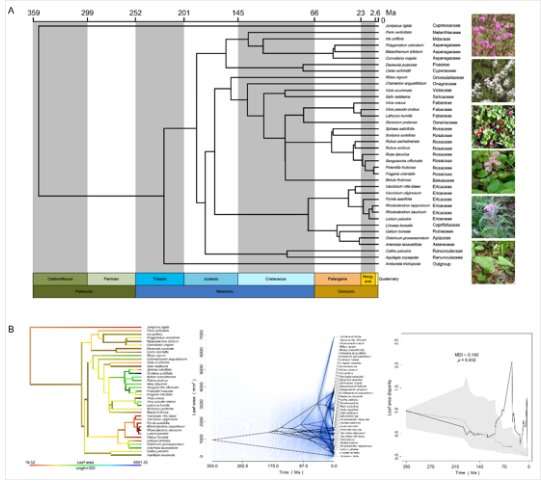How do functional traits diversify and phylogenetically correlate for co-occurring understory species in boreal forests?

Determining the processes and mechanisms underlying community assembly is a favorite pastime for ecologists. During the past decade, functional trait-based approaches have been widely used to test mechanistic community assembly hypotheses through quantifying functional patterns, which could reflect different ecological processes acting on community assembly with diversified evolution of functional traits.
Although ecologists have predicted how variation in functional trait values affect species interactions, community composition, and ecosystem functioning, the diversification and phylogenetic correlation of functional traits for the co-occurring species within a community over geological time are often unknown.
Liu Bo from the Institute of Applied Ecology of the Chinese Academy of Sciences, together with his collaborators, has utilized phylogenetic comparative analysis to examine how functional traits diversified and phylogenetically correlated for co-occurring understory species.
The researchers measured six functional traits for 37 boreal understory species in the field, including leaf area, leaf carbon content, leaf dry matter content, leaf nitrogen content, plant height, and specific leaf area. They constructed a phylogenetic tree with three loci (rbcL, matK, and trnH-psbA) to perform phylogenetic comparative analyses.
The results of low levels of phylogenetic niche conservatism for the measured understory traits indicate species co-existing in a local community do not necessarily need to share similar functional traits, namely trait diversification. In addition, there were both positive and negative phylogenetic correlations among the six measured traits during the processes of trait diversification.
Those understory species were distantly related in phylogeny and had both positively and negatively correlated adaptions, corresponding to resource acquisition strategies under the harsh environmental conditions and fire disturbance, according to the researchers.
The study, "Diversification and phylogenetic correlation of functional traits for co-occurring understory species in the Chinese boreal forest," was published in the Journal of Systematics and Evolution.
More information: Bo Liu et al, Diversification and phylogenetic correlation of functional traits for co‐occurring understory species in the Chinese boreal forest, Journal of Systematics and Evolution (2022). DOI: 10.1111/jse.12840
Provided by Chinese Academy of Sciences




















